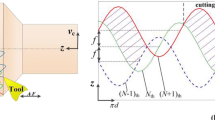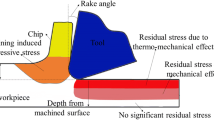Abstract
High-feed axial ultrasonic vibration turning (HFUVT) is studied to explore its effects on the machining characteristics of Ti6Al4V alloy. A feed rate that is greater than the ultrasonic vibration amplitude was employed to turn this titanium alloy. The kinematics and tool flank extrusion models were established for the cutting process. Then, systematic simulation and experimental investigations were carried out to compare and analyze the cutting characteristics including the chip geometry, subsurface plastic deformation and cutting force in conventional turning (CT) and HFUVT. The results indicated that the cutting efficiency of HFUVT increased by more than 3.4 times compared with that of CT. The HFUVT produced more severely deformed Sawtooth chips, smaller shear band spacing, higher chip splitting frequency, deeper subsurface plastic deformation layer and lower cutting force. The insightful findings contribute to a comprehensive understanding of the HFUVT process and offer valuable guidance for the improving of cutting efficiency in machining difficult-to-cut materials.


















Similar content being viewed by others
Data availability
Data will be made available on request
References
Ezugwu EO, Wang ZM. Titanium alloys and their machinability: a review. J Mater Process Technol. 1997;68:262–74.
Amit P, Sushil I. Machining challenges in Ti-6Al-4V: a review. Int J Innov Eng Technol. 2015;5(4):6–23.
Jianyong L, Lihong Q, Wuyi C. Cutting force analysis in machining of titanium alloy with solid carbide cutters of different geometriy. MATEC Web Conf. 2018;179:02002.
Qian X, Duan X, Zou J. Effects of different tool microstructures on the precision turning of titanium alloy TC21. Int J Adv Manuf Technol. 2020;106:5519–26.
Limin S. Investigation of tool wear and surface roughness when turning titanium alloy (Ti6Al4V) under different cooling and lubrication conditions. Ferroelectrics. 2018;526:199–205.
Zhang J, Tang L, Ma F, Hu Y, Li B, Sun Y. Experimental investigation of the low-temperature oil-on-water cooling and lubrication in turning the hardened AISI D2 steel. Int J Adv Manuf Technol. 2023;125:1161–77.
Brehl DE, Dow TA. Review of vibration-assisted machining. Precis Eng. 2008;32:153–72.
Yang Z, Zhu L, Zhang G, Ni C, Lin B. Review of ultrasonic vibration-assisted machining in advanced materials. Int J Mach Tools Manuf. 2020;156: 103594.
Muhammad R, Hussain MS, Maurotto A, Siemers C, Roy A, Silberschmidt VV. Analysis of a free machining α+β titanium alloy using conventional and ultrasonically assisted turning. J Mater Process Technol. 2014;214:906–15.
Patil S, Joshi S, Tewari A, Joshi SS. Modelling and simulation of effect of ultrasonic vibrations on machining of Ti6Al4V. Ultrasonics. 2014;54:694–705.
Airao J, Nirala CK, Bertolini R, Krolczyk GM, Khanna N. Sustainable cooling strategies to reduce tool wear, power consumption and surface roughness during ultrasonic assisted turning of Ti-6Al-4V. Tribol Int. 2022;169: 107494.
Sutter G, List G. Very high speed cutting of Ti–6Al–4V titanium alloy – change in morphology and mechanism of chip formation. Int J Mach Tools Manuf. 2013;66:37–43.
Chen X, Tang J, Ding H, Liu A. A new geometric model of serrated chip formation in high-speed machining. J Manuf Process. 2021;62:632–45.
Luo H, Wang Y, Zhang P. Effect of cutting and vibration parameters on the cutting performance of 7075–T651 aluminum alloy by ultrasonic vibration. Int J Adv Manuf Technol. 2020;107:371–84.
Lotfi M, Amini S, Akbari J. Surface integrity and microstructure changes in 3D elliptical ultrasonic assisted turning of Ti–6Al–4V: FEM and experimental examination. Tribol Int. 2020;151: 106492.
Sui H, Zhang X, Zhang D, Jiang X, Wu R. Feasibility study of high-speed ultrasonic vibration cutting titanium alloy. J Mater Process Technol. 2017;247:111–20.
Jiang X, Zhang X, Zhu X, Sui H, Zhang D. Study of phase shift control in high-speed ultrasonic vibration cutting. IEEE Trans Industr Electron. 2018;65:2467–74.
Schubert A, Nestler A, Pinternagel S, Zeidler H. Influence of ultrasonic vibration assistance on the surface integrity in turning of the aluminium alloy AA2017. Mat-Wiss Werkstofftech. 2011;42:658–65.
Liu X, Wu D, Zhang J. Fabrication of micro-textured surface using feed-direction ultrasonic vibration-assisted turning. Int J Adv Manuf Technol. 2018;97:3849–57.
Wang DL, Dou JM, Peng W, Zhang HM. Experimental investigations in axial ultrasonic vibration turning hydraulic spool valve core. Mod Manuf Eng. 2020;41(3):97–101.
Sui H, Zhang L, Wang S, Gu Z. Feasibility study on machining extra-large aspect ratio aviation deep-hole Ti6Al4V part with axial ultrasonic vibration-assisted boring. Int J Adv Manuf Technol. 2022;118:3995–4017.
Jian ZHU, Zhen YTN, Kun Z, et al. Experimental study of axial ultrasonic vibration turning 316L stainless steel. Mach Tool Hydraul. 2022;50(24):1–8.
Liu X, Zhang J, Hu X, Wu D. Influence of tool material and geometry on micro-textured surface in radial ultrasonic vibration-assisted turning. Int J Mech Sci. 2019;152:545–57.
Obikawa T, Usui E. Computational machining of titanium alloy: finite element modeling and a few results. J Manuf Sci Eng. 1996;118:208–15.
Mabrouki T, Girardin F, Asad M, Rigal J-F. Numerical and experimental study of dry cutting for an aeronautic aluminium alloy (A2024–T351). Int J Mach Tools Manuf. 2008;48:1187–97.
Meyer HW Jr, Kleponis DS. Modeling the high strain rate behavior of titanium undergoing ballistic impact and penetration. Int J Impact Eng. 2001;26(1):509–21.
Leseur D., Experimental Investigations of Material Models for Ti-6AL4V and 2024-T3, (1999).
Altintas Y. Manufacturing automation: metal cutting mechanics, machine tool vibrations, and CNC design. New York: Cambridge University Press; 2000.
Childs THC, Arrazola P-J, Aristimuno P, Garay A, Sacristan I. Ti6Al4V metal cutting chip formation experiments and modelling over a wide range of cutting speeds. J Mater Process Technol. 2018;255:898–913.
Zhao Y, Li J, Guo K, Sivalingam V, Sun J. Study on chip formation characteristics in turning NiTi shape memory alloys. J Manuf Process. 2020;58:787–95.
Bai W, Sun R, Roy A, Silberschmidt VV. Improved analytical prediction of chip formation in orthogonal cutting of titanium alloy Ti6Al4V. Int J Mech Sci. 2017;133:357–67.
Shuang F, Ma W. Numerical investigation of orthogonal cutting processes with tool vibration of Ti6Al4V alloy. Procedia CIRP. 2019;82:267–72.
Prabhakar A, Verma GC, Krishnasamy H, Pandey PM, Lee MG, Suwas S. Dislocation density based constitutive model for ultrasonic assisted deformation. Mech Res Commun. 2017;85:76–80.
Yang Q, Wu Y, Liu D, Chen L, Lou D, Zhai Z, Liu Z. Characteristics of serrated chip formation in high-speed machining of metallic materials. Int J Adv Manuf Technol. 2016;86:1201–6.
Bai W, Roy A, Guo L, Xu J, Silberschmidt VV. Analytical prediction of shear angle and frictional behaviour in vibration-assisted cutting. J Manuf Process. 2021;62:37–46.
Arefin S, Zhang X, Kumar AS, Neo DWK, Wang Y. Study of chip formation mechanism in one-dimensional vibration-assisted machining. J Mater Process Technol. 2021;291: 117022.
Huang J, Kalaitzidou K, Sutherland JW, Aifantis EC. Validation of a predictive model for adiabatic shear band formation in chips produced via orthogonal machining. J Mech Behav Mater. 2007;18:243–64.
Mitrofanov AV, Babitsky VI, Silberschmidt VV. Finite element simulations of ultrasonically assisted turning. Comput Mater Sci. 2003;28:645–53.
Barry J, Byrne G. Study on acoustic emission in machining hardened steels Part 1: acoustic emission during saw-tooth chip formation. Proc Inst Mech Eng, Part B: J Eng Manuf. 2001;215:1549–59.
Molinari A, Musquar C, Sutter G. Adiabatic shear banding in high speed machining of Ti–6Al–4V: experiments and modeling. Int J Plast. 2002;18:443–59. https://doi.org/10.1016/S0749-6419(01)00003-1.
Molinari A, Soldani X, Miguélez MH. Adiabatic shear banding and scaling laws in chip formation with application to cutting of Ti–6Al–4V. J Mech Phys Solids. 2013;61:2331–59.
Hou ZB, Komanduri R. Modeling of thermomechanical shear instability in machining. Int J Mech Sci. 1997;39:1273–314.
Ye GG, Chen Y, Xue SF, Dai LH. Critical cutting speed for onset of serrated chip flow in high speed machining. Int J Mach Tools Manuf. 2014;86:18–33.
Zhang L, Hashimoto T, Yan J. Machinability exploration for high-entropy alloy FeCrCoMnNi by ultrasonic vibration-assisted diamond turning. CIRP Ann. 2021;70:37–40.
Willert M, Zielinski T, Rickens K, Riemer O, Karpuschewski B. Impact of ultrasonic assisted cutting of steel on surface integrity. Procedia CIRP. 2020;87:222–7.
Li X, Yang S, Lu Z, Zhang D, Zhang X, Jiang X. Influence of ultrasonic peening cutting on surface integrity and fatigue behavior of Ti-6Al-4V specimens. J Mater Process Technol. 2020;275: 116386.
Airao J, Nirala CK, Outeiro J, Khanna N. Surface integrity in ultrasonic-assisted turning of Ti6Al4V using sustainable cutting fluid. Procedia CIRP. 2022;108:55–60.
He Y, Zhang J, Zhou W, Tang J, Xu Y, Zhang Y. Study on force reduction mechanism in ultrasonic-assisted grinding based on single-grain scratching. Arch Civ Mech Eng. 2022;22(2):80.
Airao J, Nirala CK. Analytical modeling of machining forces and friction characteristics in ultrasonic-assisted turning process. J Manuf Sci Eng. 2022;144: 021014.
Chen Z, Feng P, Wang J, Feng F, Zha H. Understanding the abnormal effects of ultrasonic vibration on tool wear and surface generation in Zr-based bulk metallic glass cutting. CIRP J Manuf Sci Technol. 2022;39:1–17.
Fang N, Wu Q. A comparative study of the cutting forces in high speed machining of Ti–6Al–4V and Inconel 718 with a round cutting edge tool. J Mater Process Technol. 2009;209:4385–9.
Airao J, Khanna N, Roy A, Hegab H. Comprehensive experimental analysis and sustainability assessment of machining Nimonic 90 using ultrasonic-assisted turning facility. Int J Adv Manuf Technol. 2020;109:1447–62.
Peng Z, Zhang X, Zhang D. Performance evaluation of high-speed ultrasonic vibration cutting for improving machinability of Inconel 718 with coated carbide tools. Tribol Int. 2021;155: 106766.
Acknowledgements
The authors gratefully acknowledge the support of the National Natural Science Foundation of China (NSFC) (Grants No. U22B2086); the National Science and Technology Major Project (Grants 2017-VII-0003-0096); the Defense Industrial Technology Development Program (Grants No. JCKY2020213B006); the National Key Laboratory of Science and Technology on Helicopter Transmission (Grant No. HTL-0-21G04).
Funding
The National Natural Science Foundation of China (NSFC), U22B2086, Jinyuan Tang, the National Science and Technology Major Project, 2017-VII-0003-0096, Jinyuan Tang, the Defense Industrial Technology Development Program, JCKY2020213B006, Wen Shao, the National Key Laboratory of Science and Technology on Helicopter Transmission, HTL-0-21G04, Wen Shao.
Author information
Authors and Affiliations
Corresponding author
Ethics declarations
Conflict of interest
The authors declare that they have no conflict of interest.
Ethical approval
This article does not contain any studies with human participants or animals performed by any of the authors.
Informed consent
None.
Additional information
Publisher's Note
Springer Nature remains neutral with regard to jurisdictional claims in published maps and institutional affiliations.
Rights and permissions
Springer Nature or its licensor (e.g. a society or other partner) holds exclusive rights to this article under a publishing agreement with the author(s) or other rightsholder(s); author self-archiving of the accepted manuscript version of this article is solely governed by the terms of such publishing agreement and applicable law.
About this article
Cite this article
Li, K., Shao, W., Tang, J. et al. Feasibility study of high feed axial ultrasonic vibration turning of Ti6Al4V. Archiv.Civ.Mech.Eng 24, 137 (2024). https://doi.org/10.1007/s43452-024-00951-4
Received:
Revised:
Accepted:
Published:
DOI: https://doi.org/10.1007/s43452-024-00951-4




